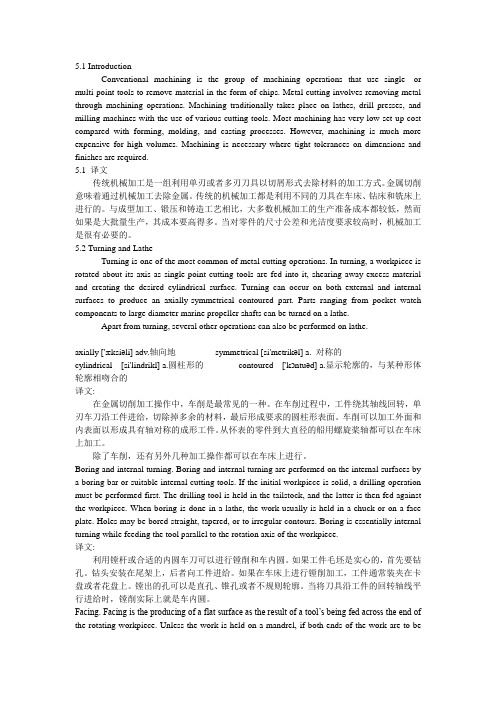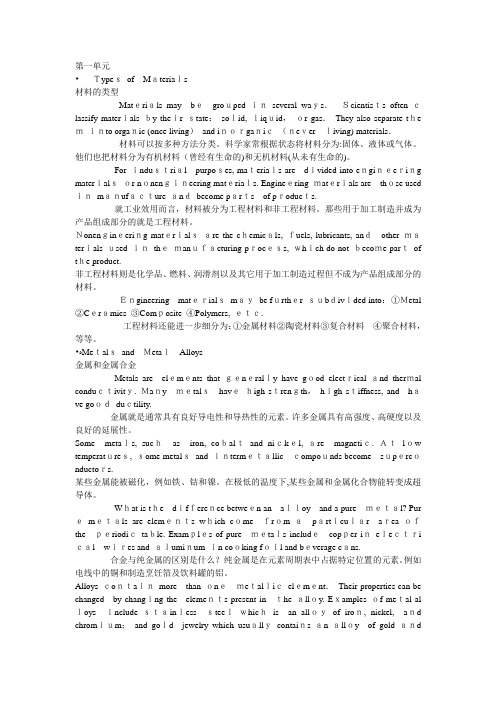机械工程专业英语 第四课文及阅读材料
- 格式:docx
- 大小:22.10 KB
- 文档页数:12

机械专业类英语文章阅读篇一:机械专业英语作文1Mechanical engineeringEngineering Science in life are widely used, especially in mechanical engineering in the application of life is almost throughout life in all its aspects, to automobiles, aircraft, small electric fans, umbrella, all of these and related machinery. The project includes many subjects, but the mechanical engineering is one of the most important subjects, not only because of our life and itis closely related to, but with the progress of the times, people have to rely on mechanical engineering products, in automation today, machine instead of many this is the part of the human labor, improve the efficiency and save time.As a result of mechanical engineering in every aspect of life, therefore, as an engineer, be faced with a great many challenges, in addition to a solid with knowledge, but also keep pace with the times, familiar with the machinery and related software, can be very good use of software, and as a an engineer, we should try our best to design and produce and closely related to the life of the machine, and can in life play a real role, also have only such, we address and remission now social needs, therefore, the mechanical engineering in the future social development, will play the important role, especially China s case, the industry also is not very developed, machinery can be greater development space.Before the industrial revolution, machinery is mostly wood structure, wood made by hand by. The development of social economy,the demand for mechanical products. The bulk of the production increasing and precision processing technology progress, promote the mass production method ( interchangeability of parts production, professional division of labor and cooperation, water processinglines and assembly lines ) formation. Study of mechanical products in the manufacturing process, especially when used in the pollution of the environment and natural resources excessive consumption problems and their treatment measures. This is a modern mechanical engineering is an especially important task to grow with each passing day, andits importance.Application of mechanical products. This includes selection, ordering, acceptance, installation, adjustment, operation, maintenance, repair and transformation of the industrial use of machinery and complete sets of machinery and equipment, to ensurethat the mechanical products in the long-term use of reliability and economy.As a student, we are now the most important to learn professional knowledge, only in this way, can we later life and learning, to doits part.机械工程工程科学在生活中应用广泛,特别是机械工程在生活中的应用几乎就是遍布了生活中的各个方面,大到汽车、飞机,小到电风扇、雨伞,这些都和机械有关。

机械专业英语文章在机械领域里,机械专业英语的特点是专业性强、范围广,重视逻辑性和条理性,因此,翻译机械专业英语工作对翻译者的翻译技能的要求也越来越高。
下面是店铺带来的机械专业英语文章,欢迎阅读!机械专业英语文章Drilling and Drills钻削和钻头Drilling involves producing through or blind holes in a workpiece by forcing a tool, which rotates around its axis, against the workpiece.钻削就是通过迫使绕自身轴线旋转的切削刀具进入工件而在其上生成通孔或盲孔。
Consequently, the range of cutting from that axis of rotation is equal to the radius of the required hole. In practice, two symmetrical cutting edges that rotate about the same axis are employed.因此从旋转轴线开始的切削范围等于所需孔的半径。
实际上使用的是两条围绕相同轴线旋转的对称切削刃。
Drilling operations can be carried out by using either hand drills or drilling machines. The latter differ in size and construction. Nevertheless, the tool always rotates around its axis while the workpiece is kept firmly fixed. This is contrary to drilling on a lathe.钻削作业既能采用手钻也能采用钻床来实现。

5.1 IntroductionConventional machining is the group of machining operations that use single- or multi-point tools to remove material in the form of chips. Metal cutting involves removing metal through machining operations. Machining traditionally takes place on lathes, drill presses, and milling machines with the use of various cutting tools. Most machining has very low set-up cost compared with forming, molding, and casting processes. However, machining is much more expensive for high volumes. Machining is necessary where tight tolerances on dimensions and finishes are required.5.1 译文传统机械加工是一组利用单刃或者多刃刀具以切屑形式去除材料的加工方式。
金属切削意味着通过机械加工去除金属。
传统的机械加工都是利用不同的刀具在车床、钻床和铣床上进行的。
与成型加工、锻压和铸造工艺相比,大多数机械加工的生产准备成本都较低,然而如果是大批量生产,其成本要高得多。
当对零件的尺寸公差和光洁度要求较高时,机械加工是很有必要的。
5.2 Turning and LatheTurning is one of the most common of metal cutting operations. In turning, a workpiece is rotated about its axis as single-point cutting tools are fed into it, shearing away excess material and creating the desired cylindrical surface. Turning can occur on both external and internal surfaces to produce an axially-symmetrical contoured part. Parts ranging from pocket watch components to large diameter marine propeller shafts can be turned on a lathe.Apart from turning, several other operations can also be performed on lathe.axially ['æksiəli] adv.轴向地symmetrical [si'metrikəl] a. 对称的cylindrical [si'lindrikl] a.圆柱形的contoured ['kɔntuəd] a.显示轮廓的,与某种形体轮廓相吻合的译文:在金属切削加工操作中,车削是最常见的一种。

•Typesof Materials材料的类型Materials may begrouped inseveral ways.Scientists often classify materials by their state:solid, liquid,or gas.They also separate the minto organic (once living)and inorganic(neverliving) materials.材料可以按多种方法分类。
科学家常根据状态将材料分为:固体、液体或气体。
他们也把材料分为有机材料(曾经有生命的)和无机材料(从未有生命的)。
For industrial purposes, materials are divided into engineering materialsor nonengineering materials. Engineering materials are those used inmanufacture andbecome parts of products.就工业效用而言,材料被分为工程材料和非工程材料。
那些用于加工制造并成为产品组成部分的就是工程材料。
Nonengineering materialsare the chemicals, fuels, lubricants, andother materials used inthemanufacturing process, which do not become partof the product.非工程材料则是化学品、燃料、润滑剂以及其它用于加工制造过程但不成为产品组成部分的材料。
Engineering materialsmaybe further subdivided into:①Metal ②Ceramics ③Composite ④Polymers, etc.工程材料还能进一步细分为:①金属材料②陶瓷材料③复合材料④聚合材料,等等。


Lesson11、the branch of scientific analysis, which deals with motions, time, and forces, is called mechanics and is made up of two parts, statics and dynamics. Statics deals with the analysis of stationary systems, i.e., those in which time is not a factor, and dynamics deals with systems, which change with time.对运动时间和作用力作出科学分析的分支成为力学。
他由静力学和动力学两部分组成。
静力学对静止系统进行分析,即在其中不考虑时间这个引述,动力学对事件而变化的系统进行分析。
2、Any two such forces acting on a body constitute a couple. The arm of the couple is the perpendicular distance between their lines of action, and the plane of the couple is the plane containing the two lines of action.作用在一个刚体上的两个这样的的里构成一个力偶。
力偶臂是这两个条作用线之间的垂直距离,力偶面是包含着两条作用线的平面。
3、Mechanics deal with two kinds of quantities: scalars and vectors. Scalar quantities are those with which a magnitude alone is associated. Examples of scalar quantities in mechanics are time, volume, density, speed, energy, and mass. Vector quantities, on the other hand, possess direction as well as magnitude. Examples of vectors are displacement, velocity, acceleration, force, moment, and momentum.力学涉及两种类型的量,标量和矢量。
《机械工程专业英语》翻译李光布饶锡新主编华中科技大学出版社Lesson11 numerical controlIntroductionOne of the most fundamental concepts in the area ……………………数控就是用一个穿孔的纸带或存储的程序来控制机床,美国电子工业协会对数字控制所下的定义为:“一个各项工作都有在各点上直接插入的数字来控制的系统,该系统必须至少能够自动解释这些数字中的部分。
”生产某个零件所需要的数据被称作这个零件程序数控比先前的手工操作生产更多的机械设备,数控机床能够自动的生产不同种类的零件,并且这些零件都有各种各样复杂的加工工艺过程,数字控制使得制造者们可以承担产品的加工,其产品的加工从经济的观点上看使用人工控制机床和加工过程是不太可行的的当一个孔被钻或冲出后,刀具向上撤回快速移动到下一个位置,重复这个步骤,路线沿着一个位置到另一个位置在某一方面是很重要的,他必须挑选一个是经过的时间减少、更有效(的路线)。
点对点的系统主要用于钻床、冲床和连续的铣工序中最近对DNC(现在表示分布式数字控制)的定义涵盖了“使用主计算机作为控制系统,来管理大量的带有机载微型计算机的独立的计算机数控机床”的含义。
这种系统提供了更大的存储和计算机能力来灵活的克服直接数控的缺陷。
计算机数字控制是由控制微型计算机作为机器集成的部分或某种设备一部分的系统(如机载计算机)。
零件程序由编程者事先准备好,该程序应结合由绘图软件包和加工仿真中获得的信息,从而确保零件没有程序缺陷。
机器操控者可以很容易的通过手工对机载计算机进行控制,操作者能够直接对程序进行修改,并为不同的零件制定和存储程序Lesson14 CAMTEXT1.introductionComputer-aided manufacturing involves the use of ……………………计算机辅佐制造的含义是:使用计算机和计算机技术来协助产品制造的所有环节,其中包括加工工艺和生产的辅助设计、加工、生产计划制定、管理和质量控制等!由CAD开发的数据库首先被存储,然后由CAM做进一步的处理,转化为对生产设备和材料处理设备进行操作和控制所必须的数据和命令,对产品的质量进行自动的检测和测试!CAD\CAM的出现对制造业有很大的影响,标准化生产的发展和设计努力、试验和原型工作的减少。
第一课Text:It is known that metals are very important in our life. Metals have the greatest importance for industry. All machines and other engineering[7endVi5niEriN] constructions have metal[5metl] parts; some of them consist only of metal parts.众所周知,金属在我们的生活中是非常重要的,金属对于工业而言是有巨大的重要性,所有机器和其他工程构造都有金属零部件,其中一些还只能由金属组成。
There are two large groups of metals:1) Simple metal- more or less pure chemical elements[5elimEnt]2) Alloys[5AlCi]- materials consisting of a simple metal combined with some other elements.有两大类金属:(1)纯金属——或多或少的金属元素(2)合金——组成纯金属的原料结合其他元素。
About two thirds of all elements found in the earth are metals, but not all metals may be used in industry. Those metals which are used in industry are called engineering metals. The most important engineering metalis iron[5aiEn], which in the form of alloys with carbon[5kB:bEn] and other elements, finds greater use than any other metal. Metals consisting of iron combined with some other elements are known as ferrous[5ferEs] metals; all the other metals are called nonferrous[5nCn5ferEs] metals. The most important nonferrous metal arecopper[5kCpE], aluminum[E5lju:minEm], lead[li:d], zinc[ziNk], tin[tin], but all these metals are used muchless than ferrous metals, because the ferrous metals are much cheaper.在地球上发现的所有元素中,大约三分之二是金属元素,但是并不是所有的金属都能够用于工业上。
2、应力和应变在任何工程结构中自力的部件或构件将接受来自于部件的使用状况或工作的外部环境的外力作用。
如果组件就处于平衡状态,由此而来的各种外力将会为零,但尽管如此,它们共同作用部件的载荷易于使部件变形同时在资料里面产生相应的内力。
有很多不合负载可以应用于构件的方法。
负荷根据相应时间的不合可分为:(a)静态负荷是一种在相对较短的时间内逐步达到平衡的应用载荷。
(b)继续负载是一种在很长一段时间为一个常数的载荷,例如结构的重量。
这种类型的载荷以相同的方法作为一个静态负荷;然而,对一些资料与温度和压力的条件下,短时间的载荷和长时间的载荷抵当失效的能力可能是不合的。
(c)冲击载荷是一种快速载荷(一种能量载荷)。
振动通常招致一个冲击载荷, 一般平衡是不克不及建立的直到通过自然的阻尼力的作用使振动停止的时候。
(d)重复载荷是一种被应用和去除千万次的载荷。
(e)疲劳载荷或交变载荷是一种年夜小和设计随时间不竭变更的载荷。
上面已经提到,作用于物体的外力与在资料里面产生的相应内力平衡。
因此,如果一个杆受到一个均匀的拉伸和压缩,也就是说, 一个力,均匀散布于一截面,那么产生的内力也均匀散布并且可以说杆是受到一个均匀的正常应力,应力被界说为应力==负载P /压力A,因此根据载荷的性质应力是可以压缩或拉伸的,并被怀抱为牛顿每平方米或它的倍数。
如果一个杆受到轴向载荷,即是应力,那么杆的长度会修改。
如果杆的初始长度L和修改量△L已知,产生的应力界说如下:应力==修改长△L /初始长L因此应力是一个丈量资料变形和无量纲的物理量,即它没有单位;它只是两个相同单位的物理量的比值。
一般来说,在实践中,在荷载作用下资料的延伸是很是小的, 丈量的应力以*106的形式是便利的,即微应变, 使用的符号也相应成为ue。
从某种意义上说,拉伸应力与应变被认为是正的。
压缩应力与应变被认为是负的。
因此负应力使长度减小。
当负载移除时,如果资料回复到初始的,无负载时的尺寸时,我们就说它是具有弹性的。
Lesson 5 lathe, shaper, grinding and milling machine 1, lathes and lathe operations Lathes are generally considered to be the oldest machine tools . although woodworking lathes were originally developed during the period 1000-1 B.C., metalworking lathes with lead screws were not built until the late 1700s .the most common lathe (figure 2.1) was originally called engine lathe because it was powered with overhead pulleys and belts from nearby engines . today these lathes are set up with individual electric motors. 1) Lathe components Lathes are equipped with a variety of components and accessories . the basic components of a common lathe are described below. i) Bed The bed supports all major components of the lathe. Beds have a large mass and are rigidly built ,usually from gray or nodular cast iron . the top portion of the bed has two ways , with various cross-sections ,that are hardened and machined for wear resistance and dimensional accuracy during use . ii) Carriage The carriage ,or carriage assembly ,slides along the ways and consists of an assembly of the cross-slide , tool post ,and apron .the cutting tool is mounted on the tool post ,usually with a compound rest that swivels for tool positioning and adjustment . the cross-slide moves radially in and out ,controlling the radial position of the cutting tool in operations such as facing. The apron is equipped with mechanisms for both manual and mechanized movement of the carriage and the cross-slide by means of the lead screw . iii) Headstock The headstock is fixed to the bed and is equipped with motors , pulleys , and V-belts that supply power to the spindle at various rotational speeds . the speeds can be set through manually-controlled selectors .most headstocks are equipped with a set of gears ,and some have various drives to provide a continuously variable speed range to the spindle. Headstock have a hollow spindle to which workholding devices ,such as chucks and collets ,are attached , and long bars or tubing can be fed through for various turning operations . iv) Tailstock The tailstock ,which can slide along the ways and be clamped at any position ,supports the other end of the workpiece . it is equipped with a tailstock center that may be fixed (dead tailstock center) or may be free to rotate with the workpiece (live tailstock center ) . drills and reamers can be mounted on the tailstock quill(a hollow cylindrical part with a tapered hole ) to drill axial holes in the workpiece. v) feed rod and lead screw the feed rod is powered by a set of gears from the headstock .it rotates during the operation of the lathe and provides movement to the carriage and the cross-slide by means of gears ,a friction clutch , and a keyway along the length of the rod . closing a split nut around the lead screw engages it with the carriage . it is also used for cutting threads accurately. vi) Workholding devices Workholding devices are particularly important in machine tools and machining operations .in a lathe , one end of the workpiece is clamped to the spindle by a chuck , collets , face plate , or mandrel. vii) Accessories Several devices are available as accessories and attachments for lathes. Among these devices are the following: Carriage and cross-slide stop with various designs to stop the carriage at a predetermined distance along the bed. Devices for turning parts with various tapers or radii Milling , sawing, gear-cutting, and grinding attachments ,and various attachments for boring ,drilling ,and thread cutting . 2) Lathe turning In a typical turning, the workpiece is clamped by any workholding devices described. Long and slender parts should be supported by a steady rest and follow rest placed on the bed ,otherwise, the part will deflect under the cutting forces. These rests are usually equipped with three adjustable fingers or rollers , which support the workpiece while allowing it to rotate freely . steady rests are clamped directly on the ways of the lathe , whereas follow rests are clamped on the carriage and travel with it . The cutting tool ,attached to the tool post , which is driven by the lead screw ,removes material by traveling along the bed , a right-hand tool travels toward the headstock , and a left-hand tool toward the tailstock. Facing cutting are done by moving the tool radially with the cross-slide, and clamping the carriage for better dimensional accuracy. 2,milling machine and milling Milling includes a number of highly versatile machining operations capable of producing a variety of configurations (figure 2.2) with the use of a milling cutter , a multitoothed cutter that produces a number of chips in one revolution . 1) Milling operations i) slab milling in slab milling ,also called peripheral milling , the axis of cutter rotation perpendicular to the workpiece surface to be machined (figure2.2(a)) . the cutter ,generally made of high-speed steel , has a